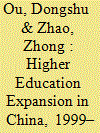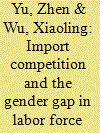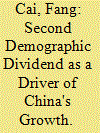|
|
|
Sort Order |
|
|
|
Items / Page
|
|
|
|
|
|
|
| Srl | Item |
| 1 |
ID:
120601


|
|
|
|
|
| Publication |
2013.
|
| Summary/Abstract |
This paper contributes to the assessment of China's rural labor markets. According to our data, the increase in off-farm employment that China experienced during the 1980s and 1990s continued during the 2000s. Our analysis shows that migration has become the most prevalent off-farm activity, although the destination of migrants is shifting from outside of one's province to destinations closer to home. The present paper finds that large shares of male and female individuals, especially those under 40 years, are working off the farm. These findings represent an important contribution to the labor economics field. First, the results of the present paper reveal that the labor transition from the agricultural sector to the non-agricultural sector for key segments of China's rural labor force is nearly complete. Second, although a large share of China's rural labor force work in agriculture, most of these workers are older men and women (and likely would not be willing to take low-wage, labor-intensive jobs). Third, the rising unskilled wage rate in China is partially a result of the tightening of the labor force in the young age cohorts. Finally, due to factors associated with the one child policy and other demographic transition forces, successive age cohorts will continue to fall in absolute number in the coming decade. Assuming China's growth continues, we expect to see further wage increases since it will take higher wages to coax more workers to work off the farm.
|
|
|
|
|
|
|
|
|
|
|
|
|
|
|
|
| 2 |
ID:
146883


|
|
|
|
|
| Summary/Abstract |
Drawing upon data from the Deployment Life Study, this article examines whether female military spouses (SPs) are disadvantaged relative to matched civilian peers in terms of hours worked and earnings, paying particular attention to gaps among the highest educated women. Female SPs do earn less than comparable civilian peers in terms of raw dollars and percentage earnings. Moreover, military wives who are part of the labor force work as many hours as their civilian counterparts, but still earn significantly less for that work. Contrary to predictions, the most educated SPs are not disproportionately affected compared to spouses with less education. These results suggest that SPs at all education levels could benefit from employment assistance; in particular, women already participating in the labor force may benefit from support in finding higher paying jobs.
|
|
|
|
|
|
|
|
|
|
|
|
|
|
|
|
| 3 |
ID:
186214


|
|
|
|
|
| Summary/Abstract |
We examine the impact of China's higher education expansion on labor market outcomes for young college graduates using China's 2005 1 Percent Population Sample Survey. Exploiting variations in the expansion of university places across provinces and high school cohorts between 1999 and 2003, we apply a difference-in-differences model and take into account the demand-side effect by using the Bartik index. We find that the expansion of higher education in China decreased unemployment rates among males and college graduates in the short term. However, the policy decreased women's labor force participation and individual earnings in high-skilled white-collar jobs. We further discuss potential channels affecting the outcomes that were observed. Our results illustrate the broad economic benefits of higher education. The findings shed new light on the contribution of young skilled labor in the economic growth of China and call for policies that can alleviate the short-term negative impact of higher education on individual students and maximize human capital. Our study also provides an interesting example of the consequences of the unequal expansion of higher education opportunities on the labor market of an emerging economy.
|
|
|
|
|
|
|
|
|
|
|
|
|
|
|
|
| 4 |
ID:
182793


|
|
|
|
|
| Summary/Abstract |
Does import competition explain the gender gap in labor force participation? The distributional consequences of trade liberalization have fascinated decades of economists and policy makers. Using a difference-in-differences strategy, we find that import competition enlarges the gender gap in labor force participation in China during 1990 and 2005. The results are robust to various identification challenges, including contemporaneous confounders, treatment effect heterogeneity, and spatial correlations in standard errors. The magnitude of the gender-differential effects of import competition on labor force participation grows by age, and peaks for people aged 46–50. The household division of labor appears to explain the gender-differential effects. Import competition also leads to a relative contraction of female-intensive industries, and reduces the share of female employees in each industry.
|
|
|
|
|
|
|
|
|
|
|
|
|
|
|
|
| 5 |
ID:
119155


|
|
|
|
|
| Publication |
2013.
|
| Summary/Abstract |
As a result of the shrinking working age population (aged 15 to 59 years), all factors that have driven China's rapid economic growth over the past 30 years tend to diminish from 2010. The present paper estimates the average annual growth rate of potential output to be 7.2 percent over the 12th Five-year Plan period and 6.1 percent over the 13th Five-year Plan period. Future sustainable growth requires furthering economic reform in related areas to enhance potential growth. This paper simulates two scenarios in which both an increase in labor force participation and improvement in total factor productivity can significantly enhance the potential GDP growth rate. Relevant policy implications are discussed.
|
|
|
|
|
|
|
|
|
|
|
|
|
|
|
|
| 6 |
ID:
175572


|
|
|
|
|
| Summary/Abstract |
As China's demographic transition enters a new stage, the “first demographic dividend” – the economic advantage resulting from demographic changes in recent decades – is bound to disappear permanently. China's future development will be characterized by an aging population. The “second demographic dividend” refers to new sources of economic growth derived from this later population change. This paper reveals major constraints caused by aging in China, which is characterized by a tendency to grow old before becoming rich. As the population ages, human capital improvement slows, labor force participation declines and consumption power reduces. This paper suggests taking advantage of a population “echo effect” to improve human capital at all ages, to enhance workers’ ability to benefit from employment, and to improve the labor participation rate of the elderly, which in turn would increase the income and social security of the aged. These measures are conducive to future economic growth and to the cultivation of the second demographic dividend.
|
|
|
|
|
|
|
|
|
|
|
|
|
|
|
|
| 7 |
ID:
147437


|
|
|
|
|
| Summary/Abstract |
Since the advent of Communist movement in the 1940s, women in China have been portrayed as equal partners to men in their labor force participation, operating under slogans such as “Women hold up half the sky”. Political rhetoric in the Mao era suggested that gender parity could be attained through women's participation in paid employment and full time work outside the home became routine for most urban women. Subsequent to the reforms, however, China has experienced a sharp decline in urban women's labor force participation. Utilizing micro-level data spanning from 1991 to 2011, individual women's labor force decisions are analyzed in order to identify the reasons for the decline. Changes in covariates explain only a small portion of the observed decline. However, over the study interval the wage returns to education increased markedly, and the distribution of wages widened considerably. These factors, combined with a high wage elasticity of participation, are consistent with the pattern of declining labor force participation found in the data. As such, promotion of women's education, particularly at the upper secondary level and beyond, could be expected to offset the downward trend.
|
|
|
|
|
|
|
|
|
|
|
|
|
|
|
|
|
|
|
|
|